M240 machine gun
| Machine Gun, 7.62 mm, M240 | |
|---|---|
|
M240B | |
| Type | General-purpose machine gun |
| Place of origin |
|
| Service history | |
| In service | 1977–present[2] |
| Used by | United States Armed Forces[2] |
| Wars | |
| Production history | |
| Designer | Ernest Vervier |
| Designed | 1950s |
| Manufacturer |
Fabrique Nationale (FN)[1] U.S. Ordnance, Inc. |
| Produced | 1977–present[2] |
| Variants | See Variants |
| Specifications | |
| Weight |
M240B: 27.6 pounds (12.5 kg) M240G: 25.6 pounds (11.6 kg) M240L: 22.3 pounds (10.1 kg) |
| Length | 49.7 in (1,263 mm) |
| Barrel length | 24.8 in (630 mm) |
| Width | 4.7 in (118.7 mm) |
| Height | 10.4 in (263 mm) |
|
| |
| Cartridge | 7.62×51mm NATO[4] |
| Action | Gas-operated, open bolt[4] |
| Rate of fire | 750–950 rounds/min |
| Muzzle velocity | 2,800 ft/s (853 m/s)[1] |
| Effective firing range | |
| Maximum firing range | 4,074 yd (3,725 m)[1] |
| Feed system | Non-disintegrating DM1 or disintegrating M13 linked belt |
| Sights | Folding leaf sight with aperture and notch, front blade |
The M240, officially Machine Gun, 7.62mm, M240, is the US military designation for the FN MAG (Mitrailleuse d'Appui Général,[5] meaning general-purpose machine gun), a family of belt-fed, gas-operated medium machine guns firing the 7.62×51mm NATO cartridge.[1]
The M240 has been used by the United States Armed Forces since the late-1970s. It is used extensively by infantry, most often rifle companies as well as ground vehicles, watercraft and aircraft. Despite being heavier than comparable weapons, it is highly regarded for reliability and its standardization among NATO members is a major advantage.
All variants are fed from disintegrating belts, and are capable of firing most types of 7.62 mm (.308) NATO ammunition. M240 variants can use non-disintegrating belts (following replacement of a few easily swappable parts). There are significant differences in weight and some features among some versions which restrict interchangeability of parts. The M240s used by the US military are currently manufactured by FN Manufacturing, a US-based branch of FN Herstal.[1]
The M240B and M240G (see Variants section) are usually fired from an integrated bipod, a vehicular mount, an M192 tripod that is mostly used by the U.S. Army; and the M122 tripod (a slightly updated M2 tripod) that is mostly used by the U.S. Marine Corps.
Development

Manufactured by Fabrique Nationale, the FN MAG was chosen by the U.S. military for different roles after large world-wide searches and competitions. The MAG is a belt-fed, gas-operated, air-cooled, crew-served, fixed headspace weapon. Its versatility is demonstrated by its ability to be mounted on the M122A1 tripod, a bipod, on vehicles, or on aircraft.
It was first adopted by the U.S. Army in 1977, as a coaxial tank gun, and slowly adopted for more applications in the 1980s and 1990s. The M240 and M240E1 were adopted for use on vehicles. This led to further adoption in more uses, especially for the Army and Marine infantry. While possessing many of the same basic characteristics as its predecessor, the durability of the MAG system results in superior reliability when compared to the M60. The MAG actually has a more complex gas system than the M60, but gives better reliability combined with lower maintenance requirements, though this comes at greater manufacturing cost and weight.
Compared to other machine guns, its rating of 26,000 Mean Rounds Between Failure (MRBF) is quite high for its weight—in the 1970s when it was first adopted it achieved about 7,000 MRBF. It is not as reliable as some very heavy older designs, but it is quite reliable for its mass.
Early history: testing and adoption

The US adoption of the MAG has its origins in the late 1960s/early 1970s as a project to procure a new coaxially mounted 7.62 mm machine gun for tanks to replace the M73 and M219 machine guns then being used. It would go on to be deployed in this role in the 1980s, but was additionally adopted for infantry and other uses. It was deployed in these new roles in the 1990s and 2000s (decade).
As mentioned, during the 1970s the Army was looking for new 7.62 mm machine guns for vehicle/AFV mounts. The 1950s-era M73 had been rather troubled, and the derivative M73E1/M219 was not much of an improvement. A number of designs of the period from various countries were considered; the final two candidates were the M60E2 and the FN MAG. They underwent comprehensive testing alongside the older M219 for comparison.
Two main criteria analyzed were Mean Rounds Between Stoppages (MRBS, jams that can be cleared within minutes) and Mean Rounds Between Failures (MRBF, such as a part breaking). The results for the evaluated machine guns were the following:
| Type | Rounds fired | MRBS | MRBF |
|---|---|---|---|
| FN MAG 58 | 50,000 | 2962 | 6442 |
| M60E2 | 50,000 | 846 | 1669 |
| M219 | 19,000 | 215 | 1090 |
| Minimum specified | 850 | 2675 | |
| Minimum desired | 1750 | 5500 |
The test applies only to the 1970s-era versions tested. The MAG itself underwent some improvements and the M60E2 was a specialized coaxial variant that differed from some of the other types. The qualities of the M60 variants vary considerably, such as between the M60E4 and the M60C. That aside, for these types the clear winner was the MAG, which was designated as the M240 in 1977 after the Army competition. It went on to replace many older types for the vehicle/coaxial role in the 1980s. The M240 proved popular enough that it was adapted by the infantry later on, spawning the M240B and M240G. The USMC adopted the M240G for this role in 1991, where it not only replaced the rather worn M60s used by the (marine) infantry, but also the M60E3 that the Marines had started using in the 1980s. In the late 1990s, the Army adopted the M240B for the infantry role - they had considered the M60E4, which (though lighter and cheaper) did not offer commonality with the vehicle borne M240, other NATO FN MAG users (such as Britain), or the USMC.
The various versions of the M240 have not yet entirely replaced all the M60 versions, though they have for most main applications and roles. The M60 is still, in some cases, used by the Navy.
Variants
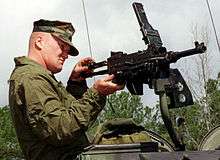

The manufacturer's name for the weapon is the MAG 58. The M240 adheres to FN MAG-58 specifications, allowing parts to be interchanged with other standard MAG-58s.[2] This has significant advantages in training, logistics support, tactical versatility, and joint operations. For example, a US unit with attached British troops could supply replacement parts for the L7s, and vice versa.[2]
M240
This was adopted in 1977 by the Army to replace the M73 and M219 7.62 mm machine guns, the Marines adopted the M240 and M240E1 for use on vehicles like the LAV-25.
U.S. Navy SEALs continue to use the "CAR-60" version (M60E3) of the M60 machine gun due to its lighter weight and slower rate of fire, which allows a move effective duration of fire with allowable levels of ammunition carried.
M240E4/M240B
The M240B is the standard infantry medium machine gun of the U.S. Marine Corps. The US Navy and Coast Guard likewise utilize the weapon system. It is also still used by some Army units. It comes configured for ground combat with a buttstock and bipod, though it can also be mounted on tripod, ground vehicles, aircraft, aboard ships and small boats. It is almost always referred to as an "M240 Bravo" or even just "240" verbally.[6]
The M60E4 (Mk 43 as designated by the U.S. Navy) was pitted against the (then called) M240E4 in Army trials during the 1990s for a new infantry medium machine gun, in a competition to replace the decades-old M60s. The M240E4 won, and was then classified as the M240B. This led to 1,000 existing M240s being sent to FN for an overhaul and a special kit that modified them for use on ground (such as a stock, a rail, etc.). This led to procurement contracts in the late 1990s for the all-new M240B. However, a new feature was added, a hydraulic buffer system to reduce the felt recoil as incorporated in the M60. While the M240B had been more reliable in the tests, it was a few pounds heavier than the M60E4, which led to the development of the lighter M240L machine gun. The Army M240 converted to the M240B configuration should not be confused with the large numbers of M240/E1 converted to the M240G configuration for the Marine Corps.
In the Marine Corps, the M240G is the predecessor of the M240B. The main differences between the two machine-gun variations is the picatinny rail system, hydraulic buffer inside of the butt stock to reduce the amount of recoil felt by the gunner, and the number of gas settings on the gas regulator plug. Where as the M240G had three gas settings, allowing the Machine-Gun to fire between 650–950 rounds per minute depending on the setting selected, the M240B only has one setting, restricting the firer to a rate of 650–750 rounds per minute. The smaller gas port used on the M240B slows down the rate of fire, which increases the longevity of the machine-gun by reducing stresses on the action. A side effect is a weapon that will not fire when extremely dirty as the energy on the piston is reduced. The Marine Corps relies on fire discipline amongst its machine gunners to not set it to the largest port unless required.
The M240B is being tested with a new adjustable buttstock that may replace the current stock of the M240B.[7] The lighter M240L has started to replace the M240B in U.S. Army service.[8] The Marine Corps is observing the progress of the M240L, but feels it is too expensive for adoption. The Corps is instead looking to upgrade the M240 barrel through several ways, including carbon fiber coatings, new alloys, or ceramic liners, to lighten and strengthen the barrel. The goal would be a barrel that would not need to be changed, would weigh the same, but decrease heat retention, lessen warping, and eliminate cook offs. They are also interested in incorporating a suppressor into the barrel, rather than having to attach one, to reduce the sound of shots and make it difficult to determine where the gunner is located.[9]
M240C
The M240C is a variation on the original coaxial (installed alongside the main weapon) M240, but with a right-handed feed for use on the M2/M3 Bradley Fighting Vehicle and LAV as the coaxial machine gun. It is fed from the left on the M1 Abrams and other M1 variant (M1A1, M1A2, M1A2 SEP) tanks. The 240C uses a charging cable instead of a charging handle, has a cut off pistol grip and has a special paddle assembly that allows the trigger to be actuated by means of a solenoid. Since the machine gun is not meant to be handled during use, the barrel is fully exposed and must be handled with asbestos mittens during barrel changes.
M240E1 and M240D
The M240D has two possible configurations: aircraft and egress (ground). The aircraft configured M240D has a front and rear sight and a trigger group which accommodates the spade grip device. The ground configuration involves the installation of an Egress Package or "infantry modification kit", which is designed to provide downed aircrew personnel with increased firepower. The M240D is an upgrade of the M240E1, primarily in the addition of an optical rail on the receiver cover. The M240E1 is also fitted with spade grips for flexible use.
M240G

The M240G allows for commonality throughout the Marine Corps whether the weapon is used in an infantry, vehicular, or airborne role. The M240G is the ground version of the original M240 or M240E1, 7.62 mm medium class weapon designed as a coaxial/pintle mounted machine gun for tanks and LAVs. The M240G can be modified for ground use by the installation of an "infantry modification kit" (a flash suppressor, front sight, carrying handle for the barrel, a buttstock, infantry length pistol grip, bipod, and rear sight assembly). The M240G lacks a front heat guard, and as such is a few pounds lighter than the M240B, weighing in at 25.6 pounds (11.6 kg). The M240G has three gas settings, allowing this weapon to fire between 650 and 950 rounds per minute. On gas setting one the weapon will fire 650–750 rounds per minute, on gas setting two the weapon will fire 750–850 rounds per minute, and on gas setting three the weapon will fire 850–950 rounds per minute. The size of the gas port increases resulting in greater energy being delivered to the action. Use at high settings induces added stresses on the action and results in a shorter service life of the weapon. It gives the operator an ability to adjust the gas bleed to the action. This also allows the weapon to continue firing when very dirty from sustained use in combat conditions when it may be otherwise rendered inoperable due to an extremely dirty and dry action.
M240E5/M240H
An improvement of the M240D, the M240H features a rail equipped feed cover, an improved flash suppressor, and has been configured so that it can be more quickly converted to infantry standard using an Egress Kit. The M240H is 41.2 inches (1,050 mm) long with a 23.6-inch (600 mm) barrel, and weighs 26.3 pounds (11.9 kg) empty.
M240L
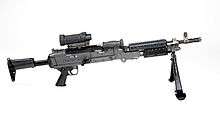
The M240L (or M240B Weight Reduction Program, formerly the M240E6), reduces the weight of the existing M240B by 5.5 pounds (2.5 kg).[10] To achieve 18% weight savings the M240L incorporates titanium construction and alternative manufacturing methods for fabricating major components. The resulting improvements reduced the soldier's combat load while allowing easier handling and movement of the weapon. The M240L may replace the M240B in U.S. Army service.[8] It was type classified in the fourth quarter of fiscal year 2010.[11][12]
Titanium was used to make the receiver body, front sight post, and carrying handle while maintaining steel operating system components. The manufacturing process had to be adjusted because titanium takes longer to machine than steel and requires more frequent replacement of tooling bits; more pliable stainless steel rivets were used and the receiver was coated with boron and chrome carbo-nitride coatings with a ceramic-based top coat to preserve it under extreme operating temperatures. The M240L weighs 22.3 lb (10.1 kg) with a standard-length barrel and standard stock, and weighs 21.8 lb (9.9 kg) with a shorter barrel and collapsible stock. The short barrel is 4 in (100 mm) shorter than a standard M240 barrel, and with the collapsible stock the M240L can be made 7 in (180 mm) shorter. The smaller and lighter variant of the M240L is the M240P, which is still in a testing phase in Afghanistan. The M240P is not used as often as its predecessors.[13][14] The Army initially bought 4,500 M240Ls, and plans to buy 12,000 total.[9]
M240L 7.62 mm Medium Machine Gun (Light) Specifications:[15]
- Operation: Gas-operated (full-auto)
- Length: 1,230 mm (48.5 in) (1,130 mm (44.5 in) with short barrel)
- Weight: 10.1 kg (22.3 lb)
- Caliber: 7.62 mm (7.62×51mm NATO)
- Maximum effective range: 1,100 meters with tripod and T&E (the latest FM reads 1,800M)
- Maximum range: 3,725 meters
- Tracer burnout: 900 meters
- Cyclic rate of fire (hydraulic buffer): 550–650 rounds per minute
Others
At the 2012 SHOT Show, Barrett Firearms Manufacturing showed off their prototype improved M240 version, called the M240LW. The M240LW is a lighter version of the M240, like the M240L, but achieves it without using alternate or expensive materials or different manufacturing techniques. It instead trims off as much metal as possible from the receiver, which is made in two pieces and then bolted together. This removes about six pounds from the original M240B.[16]
Operation

Loading the M240 can be done either with the bolt forward or to the rear. If the bolt is to remain forward, the operator will then load the rounds into the feeding block (feed tray cover closed); or will open the feed tray cover, load the rounds onto the feeding tray, then close the feed tray cover. The charging handle will then be pulled to the rear, which locks the bolt to the rear. The weapon is then placed on safe and the charging handle is then placed back to the forward position (this is spring-loaded on the tank mounted variation). The weapon is now ready for operation.
The weapon fires from the open bolt position, meaning that the bolt is held to the rear and only moves forward as it is firing a round. The firing pin is static and the bolt moves around the firing pin, circumventing any need for a hammer. A sear is used to time the internal mechanisms of the weapon to provide a consistent rate of fire, ensuring proper function and accuracy. However, firing from an open bolt also provides the possibility of an accidental discharge due to a bolt override. This happens when there is enough force for the bolt to jump over the sear and fire without the trigger being pulled. The safety on the weapon cannot stop this from happening. The safest way to protect against this is to leave the bolt forward on the weapon until the operator is ready to fire the weapon; then charge the weapon and fire.
Clearing the weapon is performed by ensuring that the bolt is locked to the rear and the weapon is on safe. The top cover is then lifted, the remaining belt (if any) is swept out of the feed tray, the feed tray is lifted to visually inspect the chamber and the face of the bolt. Any links or brass casings are removed. The weapon is now clear. In the extremely unlikely event that a live round is on the bolt face, it is knocked loose with a cleaning rod or another rigid object. If there is a live round lodged in the barrel, the operator must immediately decide if the barrel is hot enough that there is a chance of it cooking off. If there is, he will immediately move his face away from the opening of the weapon; and aiming the gun is a direction that is perceived to take the least amount of damage and/or casualties should the event of a cook-off occur. He should then wait for the barrel to cool off before attempting to remove it. He can also attempt to extract the round by closing the cover, taking the weapon off of safe, and pulling the trigger. This will likely causing the weapon to fire, so care should be made in ensuring that the weapon is first pointed in a safe direction.
The rate of fire may be controlled by three different settings. The first setting allows the weapon to cycle at 750 round/min. The two remaining settings increase the rate of fire by 100 round/min per setting (the second setting being 850 round/min, and the third setting 950 round/min). These settings are changed by dismounting the barrel, removing the gas regulator collar and turning the gas regulator to allow more or less gas to move through the weapon system. It is generally performed only when necessary to return the gun to operation after fouling has caused sluggish operation and there is no time to properly clean the weapon.
The barrels can be exchanged rapidly, thanks to a barrel release button located on the left side of the weapon. The weapon is cleared first and then the button is held down, while the barrel's carrying handle is moved from the right side of the weapon to the center, unlocking it from the receiver. At this point, the button is released and the barrel is then pulled free of the receiver and placed to the side. The new barrel is inserted into the receiver and then the carrying handle is shifted to the right, locking it into place. Headspace is set by counting the clicks as the barrel is locked down and should be between two and seven clicks.
During prolonged firing, care must be taken to not allow exposed skin to come in contact with the weapon. The barrels can become hot enough to inflict second degree burns instantly without becoming visibly different. These hot barrels glow brightly to anyone using any sort of optics sensitive to infrared radiation, such as night vision devices.
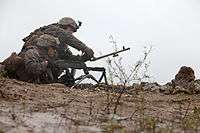 Barrel change
Barrel change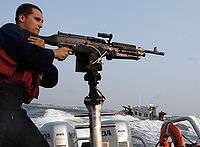 A member of a U.S. Coast Guard Maritime Safety and Security Team mans an M240B aboard a 25-foot (7.6 m) Response Boat – Small.
A member of a U.S. Coast Guard Maritime Safety and Security Team mans an M240B aboard a 25-foot (7.6 m) Response Boat – Small. M240D machine gun is fired from a SH-60F Sea Hawk.
M240D machine gun is fired from a SH-60F Sea Hawk.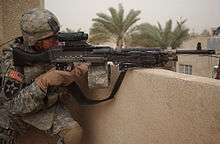 A U.S. 2nd Infantry Division soldier pulls security on top of a roof using an M240B with an attached M145 and AN/PEQ-2.
A U.S. 2nd Infantry Division soldier pulls security on top of a roof using an M240B with an attached M145 and AN/PEQ-2. M240L Machine Gun on the M192 Lightweight Ground Mount.
M240L Machine Gun on the M192 Lightweight Ground Mount. Infantryman patrolling with the M240B
Infantryman patrolling with the M240B
Feedback on the M240B
The M240B is a successful and well-regarded weapon system that has proven itself in combat in Afghanistan and Iraq, serving as a powerful supplement to the lighter 5.56 mm–based M249, M16, and M4. Its 7.62 mm round provides good penetration and stopping power, a characteristic that is especially appreciated in the urban environments where many Iraqi engagements took place. Overall, the M240B's combat record must be considered superior to the problematic M60 that it has entirely replaced in US service. An April 2002 presentation by the Natick Soldier Center reported on lessons learned from M240B use in Afghanistan:
- 17% reported engaging the enemy with their M240B;
- 42% reported problems getting spare parts in Afghanistan (barrels, springs, small roll pins, T&E (transversing & elevation) pin, heat shields, sear pins, spare barrel bag, cleaning materials);
- 1 soldier reported a double feed in combat; This was probably a failure to extract and not a double feed.
- 50% reported that they need better ways to carry ammunition (ammo bag, etc.);
- 82% thought their M240B was reliable;
- 60% thought it needed to be easier to carry, and to set up.
- Suggestions: improved sling; lighter, more durable tripod; more durable heat shield.
On 15 May 2003, an "Operation Iraqi Freedom PEO Soldier Lessons Learned" report by LTC Jim Smith, U.S. Army, was published. The report made the following comments on the M240B:
Soldiers have great confidence in this weapon. Again, the vast majority of comments were positive. Most negative comments were relative to the AG's load. Soldiers recommended fabricating the tripod out of a lighter material. The AG bag is not integrated into the remainder of the MOLLE and, therefore, is not easily carried. Additionally, the nylon bag melts when it comes in contact with a hot barrel. Other suggestions included adding collapsible bipod legs like the squad automatic weapon (SAW), wiring down the heat shields and an ammunition carrying system to carry 300–400 linked rounds.[17]
A May 2006 presentation by the US Army Infantry Center reported these conclusions on the M240B:
- Soldier ratings consistently highly positive
- Great rate of fire and target effects
- Good durability
These comments were based on a survey of 3,300 soldiers from eight divisions of the U.S. Army (active, Guard, and reserve).
Users
 Afghanistan: Orders by Afghan National Army
Afghanistan: Orders by Afghan National Army Spain: Used by the Spanish Army Airmobile Force [18]
Spain: Used by the Spanish Army Airmobile Force [18] United States: Standard to all units of the US Army, also used by US Air Force Security Forces
United States: Standard to all units of the US Army, also used by US Air Force Security Forces Pakistan: In service with Pakistan Army
Pakistan: In service with Pakistan Army Mauritius: Used by Military of Mauritius.
Mauritius: Used by Military of Mauritius. Philippines: Used by the Philippine Army, Philippine Marine Corps and Philippine National Police-Special Action Force.
Philippines: Used by the Philippine Army, Philippine Marine Corps and Philippine National Police-Special Action Force. Sweden: Used by the Swedish Armed Forces, license made in Sweden and designated as Ksp 58 (short for "Kulspruta", swedish for "Machine gun" of model 1958). [19]
Sweden: Used by the Swedish Armed Forces, license made in Sweden and designated as Ksp 58 (short for "Kulspruta", swedish for "Machine gun" of model 1958). [19]
See also
- MG3 (7.62 mm machine gun)
- PKM (7.62 mm machine gun)
- IMI Negev (5.56 mm machine gun with 7.62 mm version)
- CETME Ameli
- M249 Squad Automatic Weapon (5.56 mm machine gun)
- UKM-2000 Polish (7.62 × 51 mm machine gun)
- M60 machine gun (7.62 mm machine gun)
- Mk 48 Mod 0 (M249-derived 7.62 mm machine gun)
- List of firearms
- List of weapons of the U.S. Marine Corps
- List of individual weapons of the U.S. Armed Forces
- List of crew-served weapons of the U.S. Armed Forces
References
- 1 2 3 4 5 6 7 "M240 Family of Medium Machine Guns". FN Manufacturing, LLC. October 12, 2006. Retrieved January 16, 2011.
- 1 2 3 4 5 "FN Machine Guns: M240 Series". FNH USA. 2011. Retrieved January 16, 2011.
- ↑ http://armamentresearch.com/us-m240l-gpmg-seen-with-jabhat-al-nusra-fighter-in-syria/
- 1 2 "M240B". FNH USA. Archived from the original on 15 February 2012.
- ↑ World Gun's FN MAG page. Retrieved on November 21, 2008.
- ↑ "Ohio Ordnance Works". ohioordnanceworks.com. Retrieved 3 October 2016.
- ↑ "Fort Benning Soldiers evaluate redesigned buttstock for M-240B, M-249". tactical-life.com. 31 July 2009. Retrieved 3 October 2016.
- 1 2 Lance M. Bacon (30 April 2011). "Improved carbines headed your way". Gannett Government Media Corporation. Retrieved 30 April 2011.
- 1 2 Corps Not Looking at M240L — But a Silenced M240B? - Kitup.Military.com, 10 January 2011
- ↑ Herring, Nate D. (28 October 2009). "PEO Soldier Unveils New Equipment". Military Daily News - Military.com. Archived from the original on 1 November 2009. Retrieved 3 October 2016.
- ↑ "M240L 7.62mm Medium Machine Gun (Light)" (PDF). PEO Soldier. United States Army. Archived from the original (PDF) on 13 August 2011.
- ↑ Fuller, BG Peter N.; COL Douglas A. Tamilio (18 May 2010). "Project Manager Soldier Weapons Briefing for NDIA" (PDF). PEO Soldier. United States Army. Retrieved 28 October 2010. Cite uses deprecated parameter
|coauthors=(help) - ↑ Soldiers play key role in fielding lighter machine gun - Army.mil, 15 December 2011
- ↑ The M240L: The Myth of the $86,000 Machine Gun - Guns.com, 10 February 2012
- ↑ FNH USA - Distinct Advantage :: M240L. (n.d.). Retrieved from http://www.fnhusa.com/l/products/machine-guns/m240-series/m240l/
- ↑ Barrett M240LW Prototype – The Firearm Blog, January 26, 2012
- ↑ "'Ironman' a game-changer on battlefield". army.mil. Retrieved 3 October 2016.
- ↑ Infodefensa.com (20 January 2016). "Los helicópteros Cougar y Chinook incorporarán las nuevas ametralladoras MAG-58, M3M y M-240 - Noticias Infodefensa España". infodefensa.com. Retrieved 3 October 2016.
- ↑ Försvarsmakten. "Kulspruta 58 B". forsvarsmakten.se. Retrieved 3 October 2016.
External links
| Wikimedia Commons has media related to M-240 machine gun. |
- Chapter 3, M240B Machine Gun, Field Manual 3–22.68, Crew-Served Machine Guns, 5.56-mm and 7.62-mm, Department of the Army, 31 January 2003
- Federation of American Scientists: M240
- Video #1 of M240
- M240 Gun Fact Files, US Army
- original test report of multiple machine guns, including the later M240 (as MAG58)


